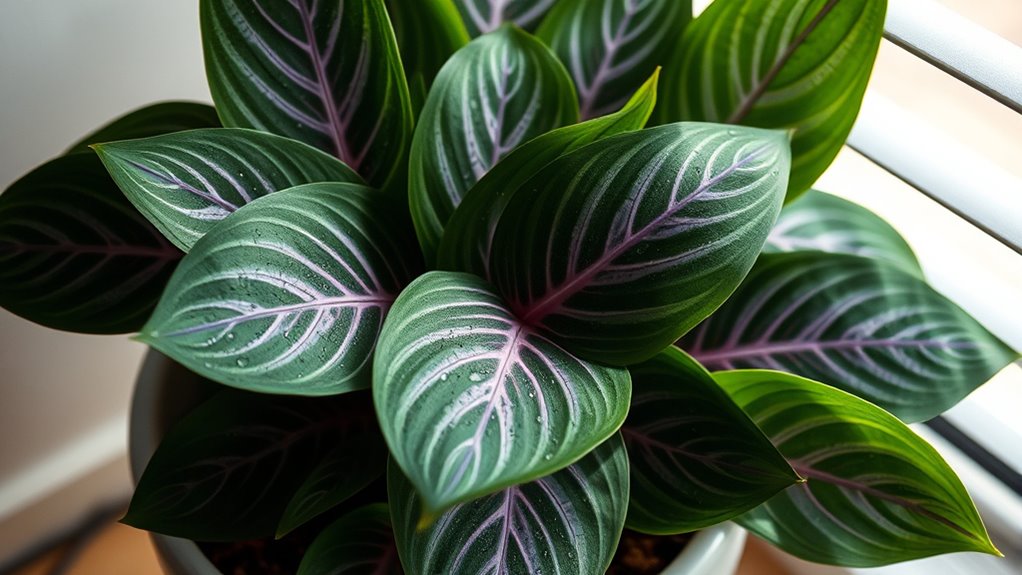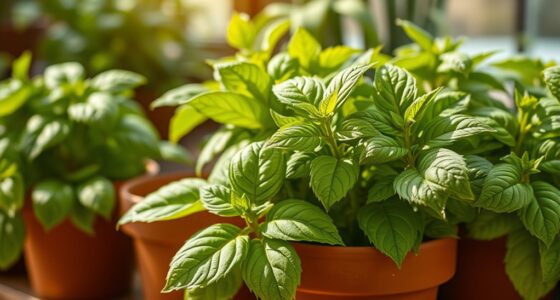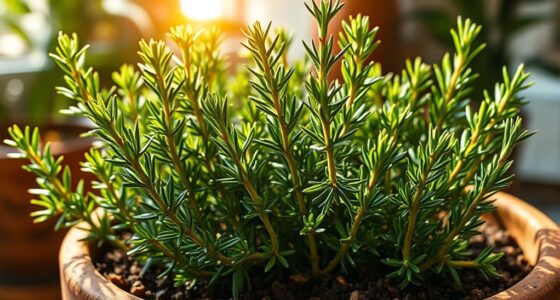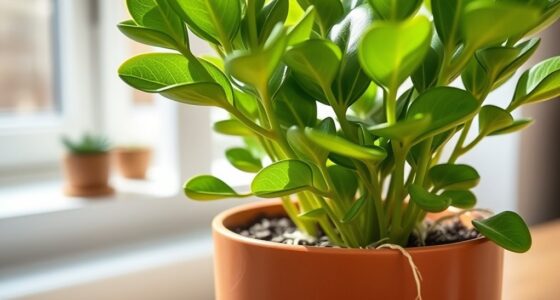To keep your Calathea vibrant, maintain a consistent watering schedule, ensuring the soil stays evenly moist but not soggy—check the top inch and water thoroughly when dry. Place the plant in bright, indirect light, avoiding direct sunlight to prevent leaf scorch. Use room-temperature filtered or distilled water to prevent browning tips. Adjust watering according to season, and provide diffused light for healthy growth. For more tips on thriving prayer plants, continue exploring the essentials of Calathea care.
Key Takeaways
- Provide bright, indirect light and diffuse direct sunlight to prevent leaf scorch and maintain vibrant patterns.
- Water consistently, keeping soil evenly moist with room-temperature filtered or distilled water to avoid leaf tip browning.
- Maintain a steady watering schedule, adjusting for seasonal changes, and avoid overwatering to prevent root rot.
- Keep the plant away from drafts and direct heat sources, and avoid sudden changes in light or watering routines.
- Ensure proper humidity levels and avoid chemicals in tap water to support healthy growth and vibrant, lively leaves.
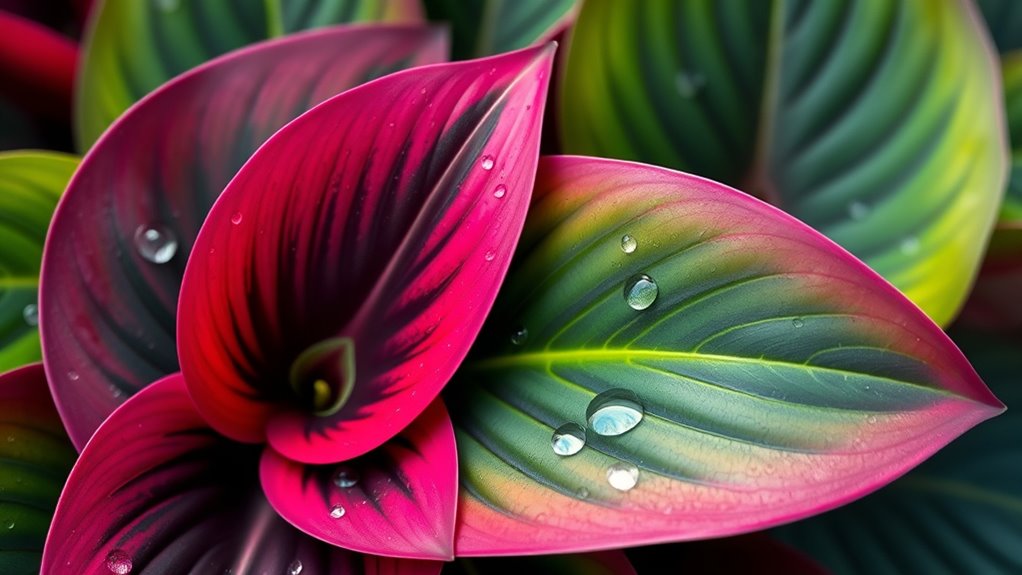
Are you wondering how to keep your Calathea healthy and vibrant? The key lies in understanding its specific needs, especially when it comes to watering schedule and light preferences. Calatheas are known for their striking foliage and unique movement, but they can quickly become unhappy if you neglect these essentials. To start, establish a consistent watering routine. These plants prefer their soil to stay evenly moist but not soggy. Check the top inch of soil regularly; if it feels dry, it’s time to water. When you do, give your plant a thorough soak until excess water drains out of the pot’s bottom. Avoid letting your Calathea sit in water, as this can lead to root rot. During warmer months, you might need to water a bit more often, but in winter, cut back slightly. Consistency is crucial, so try to stick to a regular schedule rather than watering randomly. Using room-temperature, filtered water or distilled water is best because Calatheas are sensitive to chemicals found in tap water, which can cause leaf tip browning.
Light preferences are equally important for keeping your Calathea thriving. These plants prefer bright, indirect light and can suffer if exposed to direct sunlight. Too much direct sun can scorch their leaves, causing fading or brown patches, while too little light can cause their vibrant patterns to fade. Placing your Calathea near a north or east-facing window works well because it provides gentle, filtered light. If you only have a south or west-facing window, make sure to diffuse the sunlight with a sheer curtain to prevent leaf damage. You’ll notice your Calathea’s leaves are quite sensitive to changes in light, so keep them away from drafts or direct heat sources, which can stress the plant. Maintaining the right lighting not only preserves its striking appearance but also encourages healthy growth and the characteristic movement of its leaves.
Frequently Asked Questions
How Often Should I Prune My Prayer Plant?
You should prune your prayer plant regularly to maintain its health and appearance. Use proper pruning techniques, trimming any dead or damaged leaves as needed. Perform seasonal trimming in spring or summer to encourage new growth and keep the plant looking lively. Avoid over-pruning; only remove a few leaves at a time. This routine helps your prayer plant stay vibrant and guarantees it continues to thrive in your space.
Can Calathea Tolerate Direct Sunlight?
Calathea plants prefer indirect light and can’t tolerate direct sunlight without risking leaf scorch. They thrive in conditions that mimic their native understory, so it’s best to provide bright, filtered light. When comparing sunlight vs. shade, keep in mind that too much direct sun can damage your Calathea’s delicate leaves. To keep your prayer plant vibrant, place it near a window with sheer curtains or in a shaded spot.
What Are Common Pests Affecting Calathea Plants?
Sometimes, uninvited guests like spider mites, mealybugs, or aphids can trouble your calathea. Proper pest identification is key to managing them effectively. You can try natural remedies like neem oil or insecticidal soap to keep these pests at bay. Regularly inspecting your plant helps catch issues early, ensuring your prayer plant stays healthy and vibrant. Stay vigilant, and your calathea will thrive beautifully.
How Do I Prevent Leaf Browning?
To prevent leaf browning, you should monitor your watering frequency to avoid overwatering or underwatering, which can stress the plant. Maintain high humidity levels—mist regularly or use a humidifier—to keep the leaves hydrated and vibrant. Make certain your prayer plant isn’t exposed to direct sunlight, as this can cause leaf scorch. Consistent care helps your calathea stay lush and healthy, preventing browning and promoting overall vibrancy.
Is Calathea Safe for Pets?
You wonder if calathea is safe for pets. While pet safety is a top concern, calatheas are generally non-toxic and pose minimal toxicity concerns for cats and dogs. However, it’s best to keep your pets from chewing on plants, as ingestion can cause mild stomach upset. Always monitor your pets around houseplants and consult your vet if you notice any unusual symptoms. This guarantees both your pets’ safety and plant health.
Conclusion
Now that you know how to care for your Calathea, it’s almost like fate brought you together with this stunning plant. With the right watering, lighting, and humidity, you’ll notice its vibrant leaves flourish just when you need a touch of nature’s beauty. Keep an eye on its needs, and you’ll find that nurturing your prayer plant becomes a delightful coincidence—proof that caring for it is as rewarding as the plant’s own graceful movements.
